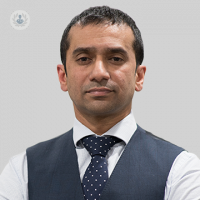Are you at risk of developing throat cancer?
Autore:The word cancer is a very emotive one naturally. Throat cancer encompasses a wide variety of diagnoses, and is probably better referred to as head and neck cancer. If you imagine the head and neck to involve two conduits or passages, one that allows food to enter the body and the other that allows for breathing and production of voice, then you can imagine a cancer can occur at any point in either of those two conduits, e.g. in the mouth, in the gullet, or in the voice box. There are other structures in the neck as well — lymph nodes, thyroid gland and saliva glands. So cancer can occur in any of these parts.

How common is throat cancer?
There are over 11,000 new cases of head and neck cancer diagnosed in the UK every year. The vast majority of them occur in the larynx, or the voice box. They tend to be almost twice as common in men, and also tend to occur mainly in those over the age of 65.
Unfortunately, over the last few years, the incidence of head and neck cancer has been increasing. That's partly because we are picking up cancers at a much earlier stage. It's predicted that the incidence may fall, particularly for voice box cancers. That is partly due to some of the victories we have in our campaign and fight against smoking.
What are the risk factors for throat cancer?
The biggest risk factor of head neck cancer by far is smoking tobacco. Alcohol consumption also increases your risk of developing throat cancer but not as much. Interestingly, those who smoke and drink develop a multiplier effect and they are at higher risk. We’re also learning about other risk factors, for example, HPV infection, which is the human papillomavirus. It’s thought that over 50% of tonsil cancers are related to HPV infections.
What are the throat cancer symptoms?
Because the term throat cancer encompasses a number of different diagnoses, there are also a number of different symptoms to be aware of.
The important ones are firstly, a hoarse or husky voice that has persisted for perhaps more than three or four weeks.
Second, dysphagia or difficulty in swallowing, particularly if this is over a period of time.
Third, an unexplained neck lump. Again, if this has lasted for more than two or three weeks and is not connected to an obvious infection or sore throat, then that is something to be concerned about. There are others but these are the important ones to remember.
Seeing a throat cancer specialist
When you see a specialist, he or she will take a detailed history encompassing all the relevant risk factors and then perform a thorough examination. During this examination, it's important to examine all the different sub-sides of the head and neck to ensure that a cancer isn't missed in any of these areas.
Nowadays, we are able to use a flexible nasendoscope, which allows us to examine the conduits I spoke about earlier. So examining the gullet, the voice box, and the back of the throat. It's a painless procedure done in outpatients and it's really an excellent tool that gives us a really excellent view of all these areas that were very difficult to examine before.
Once an examination is completed, your specialist may then request some scans and perhaps even a biopsy.
Take home messages about throat cancer
My take home messages about head and neck cancer are as follows:
- The single most effective thing you can do to avoid developing head and neck cancer is to stop smoking tobacco.
- Remember the red flag symptoms. My top three are persistent hoarseness; dysphagia or difficulty in swallowing that isn't getting better or is getting worse; and an unexplained neck lump.
- If you have any of these symptoms, my final tip is to seek attention from an expert, someone who has access to modern diagnostic technology and who works as part of a multidisciplinary team.



